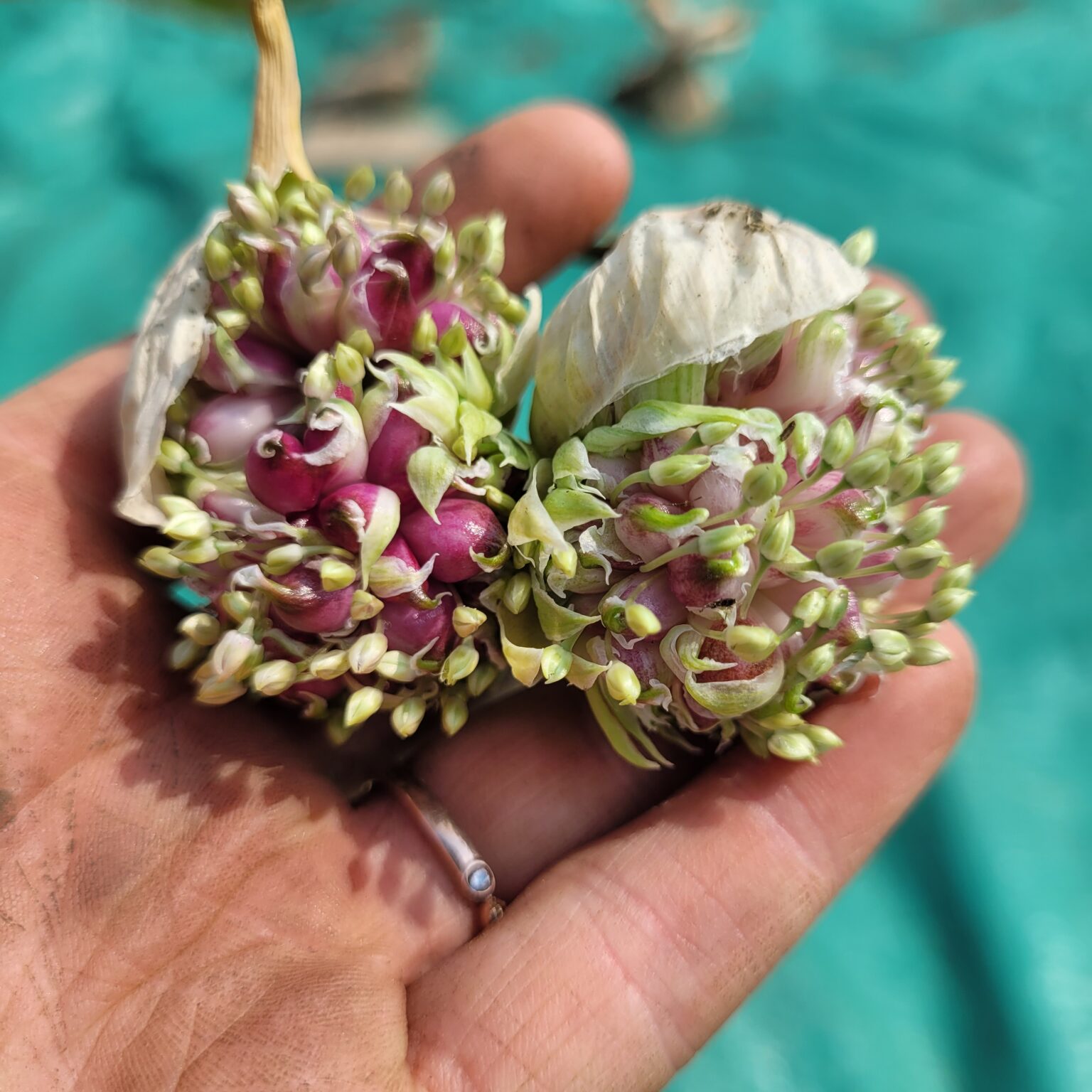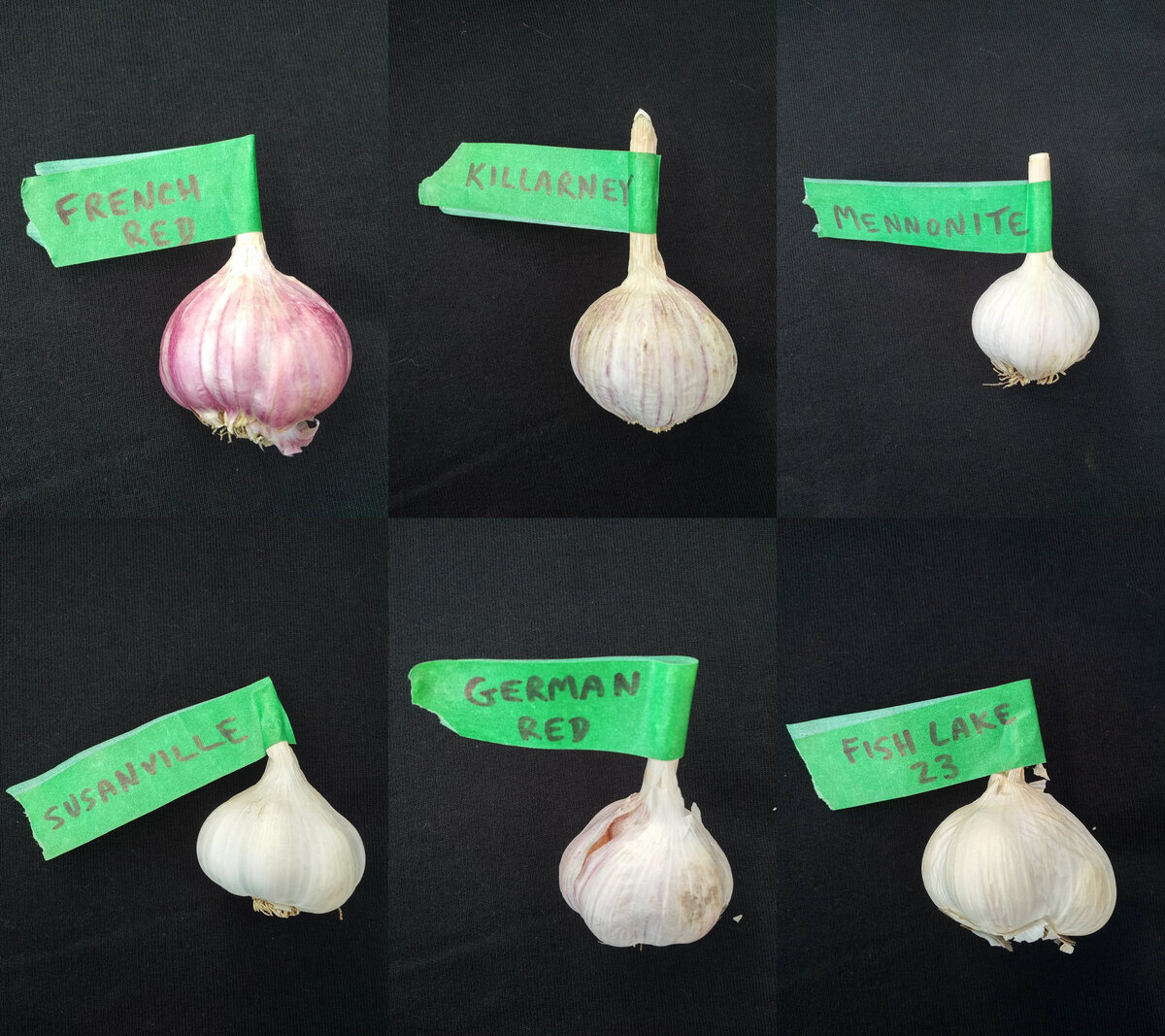Get Ready to Plant Garlic!
Why you should store garlic at room temperature
The best way to store garlic is in a dry, room-temperature place such as a kitchen cupboard. If you store it in a cold, humid place (like a fridge) it will sprout!
This is confusing because it's opposite to onions, which store well in a cold and dry place.
The difference is that garlic sprouts when cold, and onions sprout when warm, which is why we plant garlic in the fall and onions in the spring.
Now you know why, so you can remember how to store them both!

As the days get cooler and shorter, it's the ideal time to plant garlic for next year.
It might seem strange to plant a garden vegetable in the fall, but think of it this way: garlic is a bulb, just like tulips and daffodils. We plant it in the fall, it sprouts in the spring, and we harvest it in the summer!
Check out our helpful articles
- How to Plant Garlic from Bulbs
- How to Grow Garlic from Bulbils
- Seeds of Diversity's Great Canadian Garlic Collection
- Garlic Diversity and Where to Find It
Garlic Bulbils are Still Available

We have 48 varieties of garlic bulbils available for planting this fall. Bulbils - not the large bulbs that you're probably used to, but the tiny nuggets that grow in the scapes at the tops of the plants, are a very economical way to collect and grow a vast assortment of garlic varieties!
If you plant bulbils, be prepared to wait for two full years before harvesting fully-grown garlic, but the results should be better than clove-planted garlic, and growing from bulbils is a very economical way to scale up a diverse collection of varieties. Read our article to learn more: How to Grow Garlic From Bulbils
While supplies last, we will send you a good amount (at least 10) of bulbils for 5 different varieties for $15 including shipping and handling. Please order at seeds.ca/store.
We cannot guarantee specific varieties, but if you have a favourite, please ask and we'll do our best to provide what you want.
Annual Members Meeting November 23, 2024
Save the date for our annual members meeting! Join other members to discuss Seeds of Diversity's programs, membership, and ideas for the next 40 years!
3:00pm Eastern time : A zoom link will be included in a separate email for members.
Join our Board of Directors
At our Annual Meeting we will elect members to our Board of Directors. Do you love what Seeds of Diversity does and want to help make it even better? We're looking for people with skills and experience who can help strategize our work for the future. Meetings are monthly and virtual, typically no more than an hour. We're especially looking for people who have connections with the wider seed-saving community, experience in administration or governance of non-profit organizations, and availability for a one-hour virtual meeting each month.
If that sounds like you, send us an email expressing your interest and let us know
- Your background, skills, and experience with non-profits like Seeds of Diversity.
- What you feel you can offer as a board member.
- Any questions that you might have about our board, meeting style, or other roles within the organization.
Garlic Diversity and Where to Find It

There are hundreds of different varieties of garlic, which is amazing when you consider that virtually none of them are new. Efforts to breed new garlic varieties have mostly failed due to the fact that it is very difficult to save true seeds from a garlic plant. That means basically all the garlic you can find are heritage varieties from around the world, hundreds or perhaps even thousands of years old, harvested and re-planted by gardeners year after year.
When you break a garlic bulb into cloves (the individual wedges in the bulb) and plant the cloves separately, each one grows into a full bulb by the next summer, and each of those bulbs is identical to the original bulb. You aren't making new garlic plants at all - you're dividing one plant into six, eight, fifteen or more pieces that each grow back to a full plant again. Every clove makes a clone.
Nearly 400 articles on our Youth blog!

Over the last 3.5 years, Youth in Food Systems has facilitated online content creation projects, now called the Peer Led Food Media Creation. Each project offers a unique opportunity for youth participants to research and write about food topics of interest to them, and to publish what they’ve learned and created on public platforms for their peers to engage with.
The youth blog is one of these projects. It has produced, on average, two food- and sustainability-related articles each and every week since April 2021. As the project quickly approaches the 400 post milestone this year, we thought we’d celebrate this incredible journey by handpicking several posts from the last 3.5 years to feature in the e-bulletin over the next few months. And if it works well, we’ll continue so long as there are high quality, interesting posts to share!
The entire blog can be found at www.seeds.ca/schoolfoodgardens/blog
Here is the first selected feature post, from March 2023.
In this issue
Garlic Diversity and Where to Find It
Nearly 400 articles on our Youth blog!
Not yet a member?
An annual membership to Seeds of Diversity gives you access to our seed exchange, seed grow-out programs, and our online news.

We depend on donations to do our work.

Thank you for your support!
